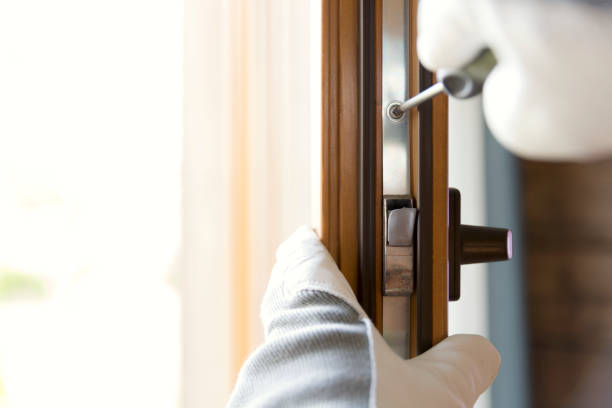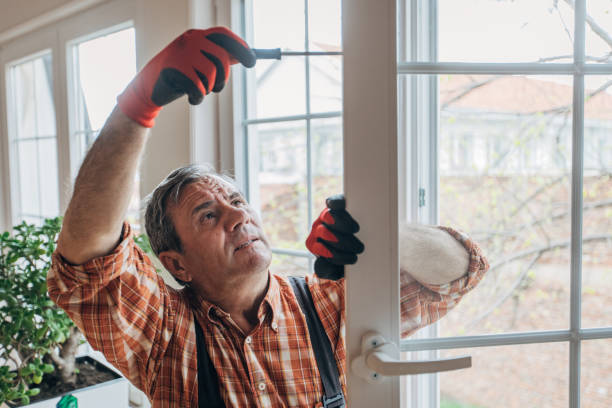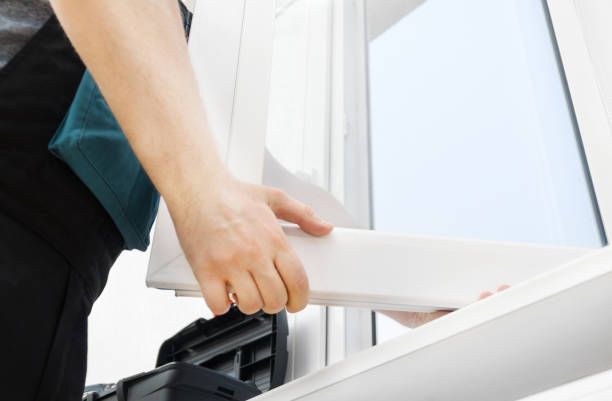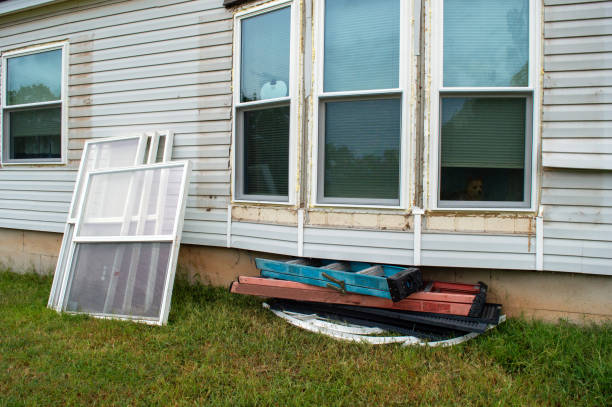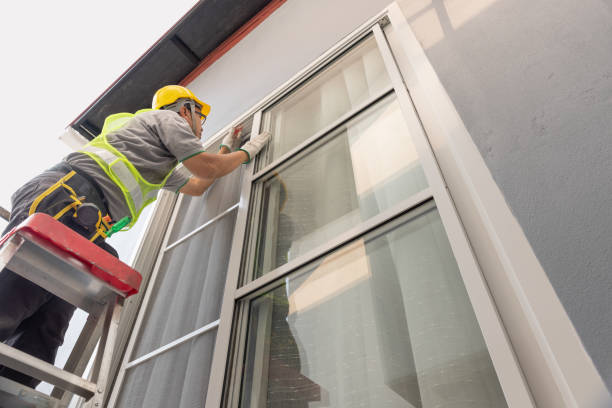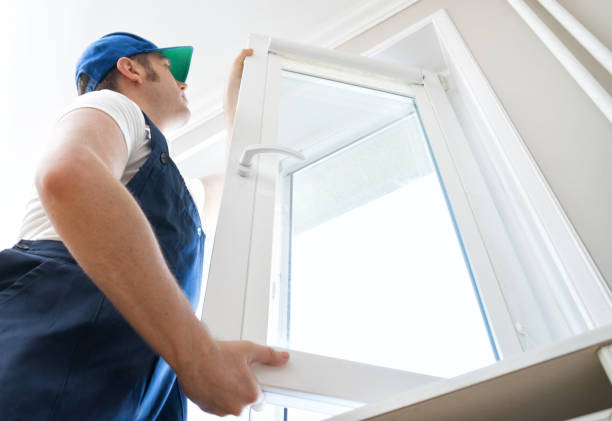
Proper window installation is crucial for ensuring energy efficiency, long-term durability, and optimal functionality. A poorly installed window can lead to leaks, drafts, and even structural issues. Below are three key indicators that can help you determine if your windows were installed correctly.
1. Visual Alignment and Fit
One of the first signs of proper window installation is how well the window fits within its frame. Misalignment issues are not only unsightly but can also compromise the functionality of the window.
- Are there visible gaps between the frame and wall?
- Does the window sit flush with the wall or siding?
- Are all corners square without uneven gaps or overlaps?
- Drafts due to air leakage.
- Water infiltration leading to moisture damage.
- Difficulty opening or closing windows due to improper alignment.
A correctly installed window should be level, plumb, and centered in its opening with minimal use of shims.
2. Energy Efficiency and Insulation Integrity
Energy efficiency is a key reason many homeowners invest in new windows. If your installation wasn’t done properly, you might notice a decrease in efficiency rather than an improvement.
- Drafts during windy conditions around the edges of the frame.
- A noticeable difference in room temperature near the windows compared to other areas.
- Higher-than-expected utility bills post-installation.
- How to Test Insulation Integrity:
| Issue | Testing Method | |————————|————————————————–| | Air Leaks | Use a candle or incense stick near seams; watch for flickering smoke. | | Poor Sealing | Look for visible caulk cracks or excessive foam around edges. | | Thermal Performance | Use an infrared thermometer to check for heat loss around frames.|
Windows should provide a tight seal against air infiltration while maintaining consistent indoor temperatures.
3. Functionality and Ease of Operation
Windows should operate smoothly after professional installation without requiring excessive force or adjustments over time.
- The sash (movable panel) opens and closes fluidly without sticking or wobbling.
- Locking mechanisms engage securely without misalignment.
- There’s no rattling when opening or closing windows during high winds.
If you experience stiffness when operating your windows or if they fail to lock properly, this might point toward shoddy workmanship during installation.
Avoiding Common Issues with Improper Windows Rockville MD Installation
| Problem | Cause | Potential Impacts |
| Water Damage | Gaps between frame and wall | Mold growth, rotting wood, structural damage |
| Condensation Between Panes | Broken seals | Reduced insulation performance |
| Sagging Frames | Improper support during installation | Operational difficulties |
Proactively addressing these issues can save time, money, and headaches in years to come.
Carefully evaluating these three factors—visual fitment, energy efficiency, and operational performance—can help determine whether your windows were installed correctly. If you notice flaws in any area highlighted above, contacting a professional contractor for an inspection may be necessary to avoid larger problems down the line.
How to Ensure Replacement Windows Rockville MD Installation Was Done Properly
Ensuring that your windows were installed correctly is crucial for maintaining energy efficiency, preventing structural damage, and maximizing the lifespan of your windows. Poor installation can lead to avoidable issues such as air leaks, water damage, and reduced functionality. Here are three key indicators to help determine whether your window installation was executed properly.
1. Proper Sealing Around the Windows
- Air Leaks: If you feel drafts coming from around the edges of a closed window, this may indicate improper sealing.
- Water Infiltration: Moisture intrusion can cause significant damage over time if water seeps through poorly sealed edges.
- Increased Utility Bills: Improperly sealed windows allow conditioned air (heating or cooling) to escape, leading to higher energy consumption.
How to Check:
- Inspect the perimeter of your windows for missing or peeling caulking.
- Look for visible gaps between the wall and frame.
- Use an incense stick or light a candle near the edge on a windy day; if smoke flickers or moves inward, there may be an air leak.
2. Smooth Operation of Windows
Properly installed windows should function effortlessly. They should open, close, and lock without sticking or requiring excessive force. Stiff operation often points to alignment issues caused by improper installation.
Issues with Poor Functionality:
- Windows that won’t stay open could indicate poor balancing in double-hung options.
- Misaligned sashes may cause rubbing or jamming during operation.
- Locks that don’t align properly with their counterparts could signal that the frame has been installed unevenly.
What to Test:
- Open and close every window in your home several times.
- Check whether locking mechanisms align correctly without forcing them into place.
- For sliding windows, ensure they glide smoothly across their tracks without resistance.
3. Lack of Drafts and Condensation Between Panes
Energy efficiency is one of the primary reasons homeowners invest in new windows. A proper installation ensures that thermal performance isn’t compromised by air leakage or broken seals within double-pane or triple-pane glass systems.
Signs That Indicate Problems: – Condensation Between Glass Panes: This indicates a broken seal in insulated glass units (IGUs), which can result from poor handling during installation. – Persistent Drafts: Even when closed tightly, drafts near improperly installed windows reduce indoor comfort.
How to Assess Thermal Performance:
| Test | Method |
| Draft Detection | Use a thermal imaging camera or smoke test mentioned above for identifying temperature drops near windows. |
| Condensation Check | Examine glass panes regularly for fogging between layers; this signals insulation failure caused by faulty seals. |
By evaluating these three key factors – sealing quality, operational ease, and energy performance – you can determine whether your window installation meets professional standards. Identifying problems early will allow you to address them before they result in more costly repairs down the line.
How the Form of Your Window Can Affect Its Performance After Installation
The form of your window plays a critical role in its overall performance after installation. A poorly designed or improperly matched window can lead to energy inefficiencies, functional problems, and even structural damage over time. Below, we’ll explore key aspects of window form and their influence on performance.
1. The Relationship Between Window Design and Energy Efficiency
Windows are a significant factor in a home’s energy efficiency. The shape, size, and material of the window frame directly impact how well it regulates indoor temperatures. Poorly chosen or designed windows can create gaps for heat transfer, impacting your heating and cooling costs.
Key considerations:
– Shape and Style: Fixed-pane windows are often more energy-efficient than operable styles due to fewer moving parts and seals. – Frame Material: Vinyl or fiberglass frames generally provide better insulation compared to aluminum frames. – Low-E Coatings: Properly designed windows should come with Low-E (low-emissivity) coatings, which reflect heat while allowing natural light to pass through.
2. Impact on Ventilation
The form of your windows determines how effectively they allow airflow into the room. Improperly installed or poorly designed windows may hinder proper ventilation, leading to stagnant air or uneven distribution of fresh air throughout your home.
Examples of window types suited for ventilation: | Window Type | Ventilation Capability | |———————|————————————————| | Casement Windows | Excellent; open fully for maximum airflow | | Sliding Windows | Moderate; only one side opens | | Awning Windows | Good; allows ventilation even during rain |
A mismatch between window form and the intended purpose can negatively affect comfort levels indoors.
3. Structural Integrity Considerations
The structure of a window should be tailored to suit its installation location. For example:
– Load-Bearing Concerns: Larger windows like picture windows require strong support from the surrounding walls. – Moisture Resistance: In areas prone to heavy rainfall, arched or awning-style windows help redirect water away from the building. – Wind Resistance: Coastal regions benefit from smaller or impact-resistant forms that withstand high winds.
When the wrong type of window is chosen—or if the form is improperly installed—it can lead to leaks, bowing frames, or premature wear from environmental stressors.
4. Matching Window Form With Aesthetic Goals
While functionality is crucial, aesthetic harmony with your home’s design matters as well: – Large bay or bow windows enhance spaciousness but require precise fitting due to their curved structure. – Oversized rectangular forms may improve natural lighting but demand robust seals around edges to prevent drafts.
Homeowners should balance visual appeal with long-term performance when selecting their window forms.
Proper consideration of a window’s form during installation ensures lasting functionality, improves energy efficiency, and enhances overall comfort indoors. By aligning design features with both practical needs and environmental conditions, you can maximize the benefits of your investment in new windows.
Examining the Function of Your Windows to Ensure Proper Installation
Properly functioning windows are an essential part of any home’s comfort, energy efficiency, and security. If your newly installed windows are not operating as they should, it may point to improper installation. Below, we explore how to examine the functionality of your windows and the indicators that suggest whether they were installed correctly.
Testing Window Functionality
- Windows should open and close smoothly without excessive force.
- Sliding windows should glide easily along the track without wobbling or sticking.
- Casement or awning windows should move freely when operated with a crank or lever.
- Locks should align perfectly with their counterparts and engage securely.
- Misaligned locks could indicate incorrect leveling during installation.
- Check for air leaks around the edges of your window frames by feeling for drafts on a windy day.
- Use a lit incense stick or candle around window seams; moving flame or smoke indicates air infiltration.
- During rainstorms, inspect for water seepage around window edges.
- Persistent moisture or water stains can signal issues with sealing or flashing.
Common Functional Issues from Improper Installation
| Issue | Potential Cause |
| Difficulty opening/closing | Frames not leveled properly during installation |
| Water leakage | Sealing was not done correctly; improper waterproofing measures |
| Drafts | Insufficient use of insulation materials around the frame |
| Condensation | Poor sealing allows moisture intrusion; double-pane glass may lose its vacuum |
Addressing these signs early can help prevent long-term damage to both your windows and surrounding walls.
Testing Thermal Efficiency with Simple Steps
- Check Internal Temperatures: On particularly hot or cold days, feel the glass’s surface from inside your home. It should retain a neutral temperature instead of feeling excessively warm or cold.
- Energy Bills Comparison: An unexpected spike in heating/cooling costs post-installation might indicate poor insulation due to gaps in fitting.
- Inspect Argon Gas Fills (For Double/Triple Pane Windows): Look for fogging between panes; this may mean the insulating gas has leaked due to seal failure associated with improper placement.
Why Proper Functionality Matters
Windows that function as intended help maintain indoor comfort, reduce energy waste, and enhance security. Malfunctioning locks can compromise safety while drafts increase utility bills unnecessarily. Regular inspections after installation ensure any potential errors are caught early before escalating into costly repairs.
By systematically examining each functional component—locks, tracks, seals, and overall weather resistance—you can determine whether your newly installed windows truly meet expectations for longevity and performance.

Examining the Function of Your Windows to Ensure Proper Installation
The functionality of your windows is one of the most critical factors in determining whether they were installed correctly. Improper window installation can lead to issues such as poor energy efficiency, water leakage, and difficulty in opening or closing the windows. Below, we’ll explore how to examine the function of your windows and identify potential installation problems.
Signs Your Windows Are Not Functioning Properly
- Difficulty Opening or Closing: A properly installed window should open and close smoothly. If you’re experiencing resistance, jamming, or uneven movement, it could indicate alignment issues or improper fitting.
- Drafts or Air Leakage: Stand near your closed windows on a windy day. If you feel air seeping through, this could mean gaps were left during installation or the sealing was inadequate.
- Water Leakage During Rain: Water intrusion is a major red flag. It often occurs when flashing isn’t applied correctly or caulking around the frame has gaps.
- Condensation Between Panes: For double- or triple-paned windows, condensation trapped between panes points to a broken seal which may have been mishandled during installation.
- Noisy Operation: Rattling sounds when opening, closing, or even during windy conditions can suggest loose components due to poor installation practices.
How to Test Your Window’s Functionality
To ensure that your window was installed properly and is performing as it should be, you can conduct several simple tests.
- Open and close each window multiple times.
- Ensure locking mechanisms align properly and engage without effort.
- Use a flashlight at night from inside while having someone inspect from outside to detect any light escaping through potential gaps.
- Run water over the exterior of your windows with a garden hose; if water leaks inside, this signals an issue with sealing.
- For advanced detection of energy inefficiencies, use a thermal imaging camera (available for rent) to identify areas where heat escapes through improperly sealed areas.
- Close all doors in your room and listen for external noise levels near the window area compared to other walls in that space; excessive noise could indicate missing insulation.
| Test Type | What It Evaluates | Tools Needed |
| Smooth Operation Check | Alignment & ease of use | None |
| Light/Gaps Inspection | Sealing & proper fitment | Flashlight |
| Water Resistance Test | Leak-free sealing | Garden hose |
| Thermal Imaging | Energy efficiency & insulation | Thermal camera |
| Soundproofing Assessment | Noise reduction ability | None |
The Importance of Window Functionality
Functional windows are crucial not only for comfort but also for maintaining energy efficiency and protecting against external elements like rain and wind. Poorly functioning windows increase energy costs due to drafts while compromising security by making it easier for intruders to access your home.
If you’ve identified signs of improper functionality after conducting these tests, consult with a professional contractor immediately. Addressing these issues early can save significant costs on repairs down the line while ensuring maximum performance from your investment in new windows.
Tips for Choosing a Contractor That Will Install Your Windows Correctly the First Time
1. Verify Credentials and Experience
A professional window contractor should have the appropriate licenses, certifications, and insurance. Here’s what you need to look for: – Licensing: Ensure the contractor has a valid license to operate in your area. – Certifications: Look for certifications from manufacturers or industry organizations (e.g., InstallationMasters or AAMA Certified). – Insurance: Confirm that they carry liability insurance and worker’s compensation.
Additionally, inquire about their experience with your specific window type or material (e.g., vinyl, wood, aluminum).
2. Check References and Reviews
A reputable contractor will have a track record of satisfied clients. Here’s how to evaluate their reputation: – Request references from past customers. – Read online reviews on platforms like Google, Yelp, or Angie’s List. – Ask about projects similar to yours to assess their expertise.
Speak directly with previous clients if possible to gain insights into their experience with the contractor.
3. Look for Detailed Written Estimates
A trustworthy contractor will provide a clear, itemized estimate before any work begins. The estimate should include: – Labor Costs: A breakdown of installation fees. – Materials: The type of windows being installed with specifications (brand, size, model). – Timeline: Project start and completion dates.
Avoid contractors who hesitate to provide detailed quotes or push verbal agreements instead of written contracts.
4. Assess Warranty Options
Reliable contractors stand by their work and materials through warranties. When selecting a contractor: – Ask about warranties on both labor (installation) and materials (windows themselves). – Understand what each warranty covers—some may exclude issues caused by improper installation.
A strong warranty is often an indicator of quality work.
5. Observe Communication Skills
Clear communication is key during any home improvement project. The right contractor should: – Respond promptly to inquiries. – Explain technical details in understandable terms. – Keep you informed throughout the project.
Miscommunication can lead to misunderstandings about timelines or costs.
6. Ask About Installation Techniques
Proper window installation requires specific techniques depending on the window type and home structure. Questions you might ask include: – “Do you use expanding foam insulation around frames?” – “How do you ensure airtight seals?”
Contractors who can clearly explain their methods demonstrate both knowledge and professionalism.
Table: Comparison Checklist for Contractors
| Criteria | Contractor A | Contractor B | Contractor C |
| Licensed & Insured | ✅ | ✅ | ❌ |
| Positive Reviews | ✅ | ❌ | ✅ |
| Detailed Estimate Provided | ✅ | ✅ | ❌ |
| Warranty Offered | ✅ | ❌ | ❌ |
Use this kind of checklist when evaluating multiple contractors side-by-side.
Final Thoughts on Choosing Your Contractor
Investing time in selecting a qualified professional ensures your windows are installed correctly from the start. By verifying credentials, comparing estimates thoroughly, and asking pointed questions about techniques and warranties, you set yourself up for success while avoiding future headaches caused by improper installations.
- Essential Things to Know About Rockville Window Replacement: A Comprehensive Guide
- How to Tell if Your Window Installation Rockville Was Done Correctly: Top 3 Indicators
- Essential Advice for Window Repair Rockville MD and Choosing Quality Replacements
- 11 Things You Should Know About Rockville Window Replacement for Your Home
- Preparing for Window Installation Rockville: Tips for a Smooth Replacement Process
- Essential Steps and Tips for Replacement Windows Rockville MD Installation Day
- Everything You Need to Know About Window Installation Rockville and Finding the Perfect Fit for Your Home
- How to Prepare for Window Repair Rockville MD and Understand the Installation Process

